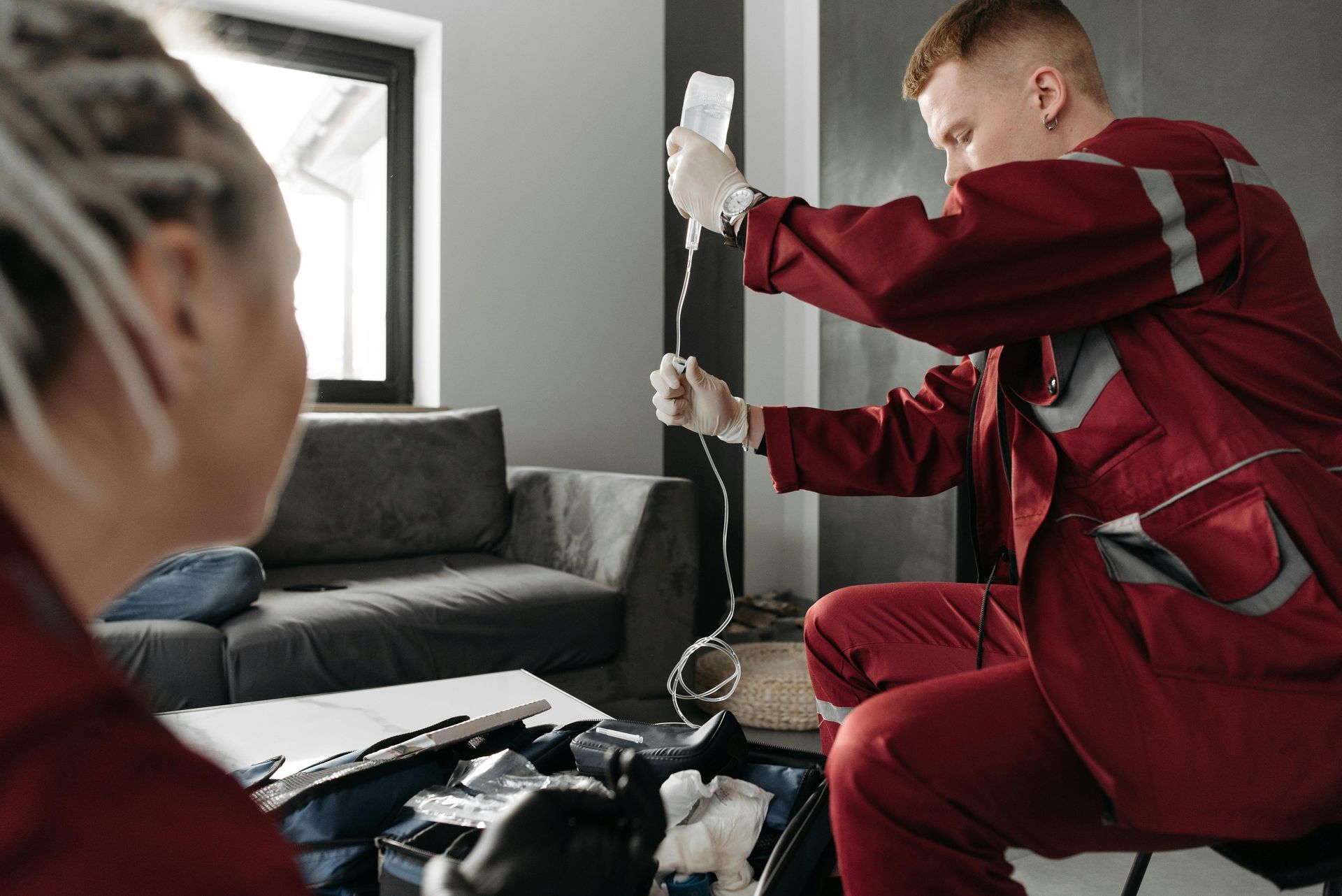IV Therapy for Kids: Safe Relief and Recovery at Home

Medically reviewed by Micaela Strevay, FNP-C, PMHNP-BC
Table of Contents
Understanding IV Therapy for Kids: A Parent's Guide to Safe Treatment
Why and When Is IV Therapy Necessary for Children?

As a parent, it's heartbreaking to watch your child struggle with illness. Children's bodies work differently than ours - they have higher metabolic rates and smaller fluid reserves, which means they can become dangerously dehydrated much faster than adults. When your little one can't keep fluids down or is losing them rapidly, IV therapy for kids becomes a lifeline.
Severe dehydration is the most common reason children need IV treatment. Whether it's from vomiting , diarrhea , or high fever , their small bodies can lose essential fluids and electrolytes faster than you might expect. When your child has been throwing up for hours and can't even keep water down, oral rehydration simply isn't enough.
Food poisoning can hit children particularly hard, causing persistent vomiting that makes it impossible to replace lost fluids by mouth. For comprehensive information about treating dehydration and IV therapy for food poisoning , these resources can help you understand when professional intervention becomes necessary.
Sometimes IV therapy is needed for post-surgical recovery when your child can't eat or drink normally. Chronic conditions like inflammatory bowel disease can also require IV support when the digestive system isn't absorbing nutrients properly. Malnutrition and electrolyte imbalances may need direct intervention to get your child back on track.
Healthcare providers use specific formulas to determine safe dosages for children. The Holliday-Segar formula calculates maintenance fluids based on weight, while emergency situations may require a bolus of 10-20 mL/kg. The key difference with pediatric care is that children need careful monitoring - their smaller size means complications can develop more quickly.
When IV Therapy is Recommended Over Oral Rehydration
| Factor | IV Therapy | Oral Rehydration |
|---|---|---|
| Speed of delivery | Immediate absorption | 30-60 minutes for effect |
| Absorption rate | 100% bioavailability | Variable, depends on gut function |
| Suitability for severe cases | Effective for all severity levels | Limited in severe dehydration |
| Ability to administer medication | Yes, concurrent medication delivery | Separate medication required |
| Patient tolerance | Works when child can't keep fluids down | Requires ability to drink and retain |
Doctors always try oral rehydration first - it's safer and less invasive. But when oral intake fails , IV therapy becomes essential. If your child has been vomiting for more than 4-6 hours and can't keep anything down, it's time to consider IV treatment.
Severe symptoms like lethargy, confusion, or your child seeming "out of it" are red flags that need immediate attention. When rapid correction is needed for dangerous electrolyte imbalances, IV therapy can literally be lifesaving. Signs of shock - including rapid heart rate, low blood pressure, or poor circulation - require emergency IV intervention.
Healthcare providers look at your child's mental state, urine output, skin elasticity, and vital signs to decide when to switch from oral to IV therapy. For detailed guidance on recognizing the signs of severe dehydration and how to treat it , understanding these warning signs can help you act quickly when your child needs help.
Common Reasons for IV Therapy for Kids
The most frequent reasons children need IV therapy for kids usually involve acute illnesses that hit suddenly. Dehydration from illness - whether it's a stomach bug, severe cold, or flu - can escalate quickly in small bodies. When your child is battling a cold and flu with severe symptoms, IV therapy can provide faster relief than oral medications, especially when their stomach is upset.
For specific guidance on IV therapy for cold and flu relief , this treatment can help your child feel better faster. Nausea and vomiting that prevents oral intake is another common reason for IV intervention. You can learn more about IV services for nausea and how it can help your child.
Post-operative care often requires IV therapy when your child can't eat or drink normally after surgery. The controlled delivery of fluids and medications helps ensure proper healing and pain management.
Some children with chronic illness management need regular IV support. Conditions like inflammatory bowel disease during flare-ups, chronic kidney disease, or cancer treatment side effects may require ongoing IV therapy. Severe infections that need antibiotic therapy and nutrient deficiencies requiring direct nutritional support are other situations where IV treatment becomes necessary.
The good news is that with proper medical supervision, IV therapy is safe and effective for children. Understanding when and why it's needed can help you make informed decisions about your child's care.
Understanding the Essentials of IV Therapy for Kids
Pediatric IV care is not just a scaled-down adult service. Kids have different fluid needs, smaller veins, and less room for error, so treatment must follow strict safety rules.
Key takeaways:
- Specialized staff – Registered nurses with pediatric experience supervise every step.
- Kid-size equipment – Smaller catheters and calibrated pumps deliver the exact volume ordered.
- Continuous monitoring – Site checks at least every hour, plus vital-sign tracking, catch problems early.
- Emergency readiness – Nurses carry supplies to manage rare reactions or complications.
For parents curious about safety outside a hospital, see our guide on mobile IV therapy safety.
The Pediatric IV Procedure: What to Expect

- Assessment & consent – The nurse reviews history, checks weight, and answers questions.
- Comfort measures – Numbing cream or cold spray reduces the brief "pinch" of insertion.
- Site selection – Hand or arm veins first; scalp veins only for tiny infants in hospital settings.
- Insertion & taping – A needle guides a soft catheter into the vein, then the needle comes out.
- Infusion – A programmed pump delivers fluids over 30–60 minutes. Intermittent (“locked”) lines are used if only occasional meds are needed.
Fluids & Dosage in Simple Terms
- 0.9 % Saline – Fast rescue for severe dehydration.
- Lactated Ringer’s – Balanced electrolytes for routine maintenance.
- Saline + 5 % Dextrose – Adds gentle energy support.
- Weight-based math – The Holliday-Segar formula sets daily needs; emergency bolus = 10–20 mL/kg.
- Less can be more – Sick kids often need 50–80 % of maintenance to avoid water overload.
Possible Side Effects (Rare but Worth Knowing)
| Issue | What you might see | Typical fix |
|---|---|---|
| Infiltration | Puffy, cool skin | Restart IV in a new vein |
| Phlebitis | Red, tender vein | Remove catheter, warm compress |
| Infection | Fever, spreading redness | Medical evaluation & antibiotics |
| Fluid overload | Swelling, trouble breathing | Pause fluids, call provider |
Professional monitoring keeps these events uncommon and quickly managed.
A Parent's Role: Preparing for and Supporting Your Child

Your calm voice and reassuring touch go further than any gadget. Children mirror adult emotions, so a steady demeanor makes the experience easier for everyone.
Quick Prep Checklist
- Explain simply : "A tiny tube puts water medicine in your arm so you feel better."
- Practice stillness : Hold still together for 10 seconds—make it a game.
- Pack comfort items : Tablet, favorite plush, snack for afterward.
- Dress smart : Loose sleeves that roll up easily.
- Eat light : Small meal 1–2 hours beforehand unless advised otherwise.
Distraction Ideas by Age
| Age | Best tools |
|---|---|
| 2–3 | Bubbles, songs |
| 4–7 | Counting games, story app |
| 8–12 | Tablet video, “I Spy” challenges |
| Teens | Earbuds, choice of music/podcast |
What to Watch For
During infusion check the site every hour for redness, swelling, or pain. Afterward, keep the bandage clean and call your provider if your child develops fever, worsening pain, or swelling.
For families who prefer in-home care, learn more about choosing an at-home pediatric nurse.
Accessing Pediatric IV Therapy
When your child needs IV therapy for kids , you have several options available, each designed to meet different needs and circumstances. Understanding these choices helps you make the best decision for your family's situation.
Hospital emergency rooms remain the go-to option for urgent situations. They're open around the clock and equipped to handle everything from minor dehydration to serious medical emergencies. The medical staff can treat children of all ages, from tiny newborns to teenagers. However, emergency rooms often mean long waits in crowded waiting areas, and your child might be exposed to other illnesses while you wait.
Urgent care clinics offer a middle ground between emergency rooms and regular doctor visits. You'll typically wait less time than at the hospital, and the cost is usually lower too. These clinics work well for non-emergency situations when your child needs IV fluids but isn't in immediate danger. That urgent care centers may not always have specialized pediatric equipment or staff trained specifically in treating children.
Specialized infusion centers create environments specifically designed for children receiving IV therapy. These facilities often have colorful décor, child-friendly amenities, and nursing staff experienced in pediatric care. You can usually schedule appointments in advance, which eliminates the uncertainty of waiting times. Some centers may have age or weight restrictions, so it's worth calling ahead to confirm they can treat your child.
Mobile IV therapy services bring professional medical care directly to your home. This option has become increasingly popular because it eliminates many of the stressors associated with traditional medical visits. Your child can receive treatment in their own bedroom, surrounded by familiar toys and comfort items.
At AZ IV Medics, we've seen how much easier IV therapy for kids becomes when delivered in the comfort of home. Children who might be anxious or uncooperative in a clinical setting often relax completely when they're in their own space. Parents tell us their kids barely notice the procedure when they're distracted by their favorite movie or book.
The convenience factor cannot be overstated. No rushing to get ready, no searching for parking, no sitting in waiting rooms filled with other sick children. Our nurses arrive at your scheduled time with all the necessary equipment and expertise to provide safe, effective treatment.
At-home IV therapy offers unique advantages that traditional settings simply cannot match. Your child experiences less stress because they're in familiar surroundings. You maintain your family's normal routines without the disruption of a medical facility visit. There's also significantly reduced risk of exposure to other illnesses - particularly important for children with compromised immune systems or those already fighting off infections.
The personalized attention your child receives during mobile IV therapy is another major benefit. Our nurses can focus entirely on your child's needs without the distractions and competing priorities found in busy medical facilities. This one-on-one care often results in a more positive experience for everyone involved.
For detailed information about IV therapy at home , you can learn about the safety protocols and professional standards that make at-home treatment both safe and effective.
We proudly serve families throughout Arizona, including Phoenix, Tucson, Scottsdale, Mesa, and Flagstaff. Our mobile service brings professional pediatric IV therapy directly to your location with no travel fees or waiting rooms. Whether your child is dealing with dehydration from a stomach bug or needs post-operative care, we're equipped to provide the same level of professional care you'd receive in a medical facility - just in the comfort of your own home.
Frequently Asked Questions About Pediatric IV Therapy
Are there age or weight restrictions for IV therapy for kids?
The short answer is yes, but it depends on where your child receives treatment. Most mobile IV therapy services, including many here in Arizona, require children to be at least 12 years old and weigh more than 100 pounds . This might seem restrictive, but there are important safety reasons behind these guidelines.
Mobile services have these requirements because younger children need more specialized equipment and precise dosing calculations. Their smaller, more delicate veins can be challenging to access, and the home environment requires children to cooperate and remain still without the restraints available in hospitals. Plus, mobile settings have limited emergency equipment compared to full medical facilities.
Hospital settings are different - they treat patients of all ages, from tiny newborns to teenagers. Hospitals have specialized pediatric equipment, advanced monitoring systems, emergency response teams, and Child Life Specialists who help children cope with medical procedures.
For children who fall outside typical mobile service parameters, medical director approval is often possible. This involves reviewing your child's medical history and current condition to determine if mobile IV therapy for kids is safe and appropriate, or if hospital-based care would be better.
At AZ IV Medics, we understand that every child's situation is unique. While we follow safety guidelines for age and weight, we're always happy to discuss your specific circumstances and explore options that might work for your family.
How is the IV fluid dosage for children determined?
Determining the right IV fluid dosage for children is like solving a personalized math problem - it's based primarily on your child's weight but involves several other important factors that healthcare providers carefully consider.
The foundation is weight-based calculations using proven formulas like the Holliday-Segar method. For maintenance fluids, providers calculate 100 mL per kilogram per day for the first 10 kilograms of body weight, then 50 mL per kilogram per day for the next 10 kilograms, and 20 mL per kilogram per day for each additional kilogram. It sounds complicated, but trained nurses handle these calculations automatically.
When children are dehydrated , providers must calculate the fluid deficit on top of maintenance needs. Mild dehydration requires replacing about 3-5% of the child's body weight in fluids, while more severe cases need increasingly aggressive replacement. For immediate resuscitation, children typically receive 10-20 mL per kilogram of body weight over less than 10 minutes.
Clinical conditions affect dosing significantly. A fever increases fluid needs by 10-15% for each degree above normal body temperature. Ongoing losses from vomiting or diarrhea must be continuously replaced. Children with heart or kidney problems may need fluid restrictions to avoid overloading their systems.
Continuous monitoring allows for adjustments throughout treatment. Providers watch how your child responds, check laboratory results if needed, monitor urine output, and adjust the dosage accordingly. This personalized approach ensures your child receives exactly what they need for optimal recovery.
Is IV therapy for kids painful?
Let's be honest - IV therapy for kids does involve some discomfort, but it's typically much less painful than parents worry it will be. Most children describe the insertion as a quick "poke," "pinch," or "bee sting" that lasts only 2-3 seconds.
The insertion process is brief but requires a moment of cooperation. The sharp sensation happens only during the initial needle insertion, then disappears once the flexible catheter is in place. Hand and arm insertions are generally more comfortable than foot insertions, which is why nurses typically choose these sites first.
Pain management makes a significant difference in your child's experience. Topical numbing cream can be applied 30-60 minutes before insertion to reduce sensation. Distraction techniques like bubbles, stories, or videos help children focus on something enjoyable instead of the procedure. Having parents present for comfort and support is invaluable.
After insertion, most children forget about the IV entirely. There might be some minor movement restrictions in the arm and possible slight skin irritation from the securing tape, but ongoing discomfort is minimal. The relief from dehydration symptoms often begins immediately, helping children feel much better quickly.
Age makes a difference in how children experience and cope with the procedure. Infants may receive sugar water for comfort, toddlers benefit most from distraction and parental presence, school-age children can understand explanations and participate in coping strategies, and teenagers often prefer more detailed information about what's happening.
With proper preparation, skilled nurses, and supportive parents, most children tolerate IV therapy remarkably well. The temporary discomfort is usually far outweighed by how much better they feel afterward.
Conclusion
When oral fluids just won’t stay down, IV therapy for kids offers rapid, reliable relief. Understanding the basics—why it’s used, how it works, and what you can do to help—turns a stressful day into a manageable one.
Need pediatric-friendly IV care at home in Phoenix, Tucson, Scottsdale, Mesa, or Flagstaff? AZ IV Medics provides scheduled visits with no travel fees and no waiting rooms.





